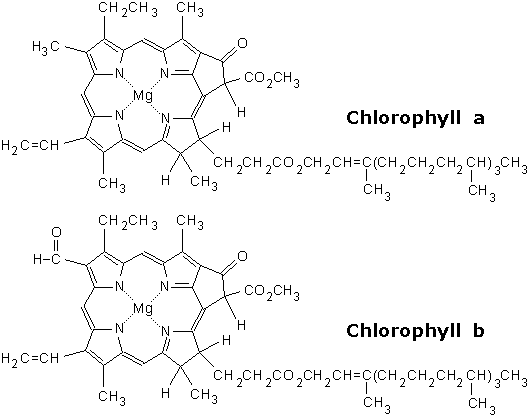Daily Newsletter March 5, 2012
Administrative Note: There are two notes today.
1) This is a milestone week. Check your calendars.
2) We have passed the midpoint of the semester, and this is when a planned change is to occur. You will notice that each news letter has guiding comments or questions to help you build your own Learning Objectives for this week.
Today's Topic: Photosynthesis
In photosynthesis, the cell will generate reducing power by using a photon to excite an electron. You will recall from chemistry that that electron excitation when an electron jumps to a higher energy state (a higher shell).
Photoexciation is one of the principle ways to excite an electron, and we can do this in a modern lab fairly easily. In nature though, you require a structure that can "focus" the photon's energy. Chlorophyll provides such a structure. As a pigment, the structure of chlorophyll is built to absorb specific wavelengths of light, and then excite a set of electrons.
Note that at the center of the chlorin ring is a Magnesium ion, which can be considered the focal point of the photoexciation.
Chlorphylls are arranged in systems, and once photoexcitation has occurred, the energy is transferred by resonant energy transfer to a Reaction Center.
The reaction center is formed by a pair of chlorophyll molecules. There are two specific reaction centers known in plants, the P680 and P700. These names refer to the maximum red absorbance wavelength for these two molecules. The P680 reaction center is found Photosystem II, while P 700 is found in Photosystem I.
NOTE: The photosystems were named in the order that they were discovered.
The reaction centers gather the energy absorbed by the surrounding chlorophyll. These reaction centers then undergo a charge separation, which is a form of redox reaction that donates high energy electrons to a waiting quinone. The image below is of photosystem II.
There are a few important points in this image:
1) Notice in the center there is a group f structures with the code Pheo. This represents a Phenophytin, which is a chlorophyll without the magnesium in the center.
The paired chlorophylls become a paired phenophytin. This change (loss of the magnesium) is a where the absorbed energy is converted to a redox potential. The energy is handed off to a quinone (Q).
2) When we discussed respiration, we discussed Ubiquinone, which is an example of a quinone. The quinones are electron carriers within the membrane. The quinones take the harvested reducing potential to electron carriers for processing.
3) Photosystem II has a way to recharge the system with electrons and hydrogen. The reaction center of photosystem II has the hydrolytic ability; it can break water. The hydrogens, and their electrons, join photosystem II, recharging the reaction center (they convert pheophytin back to chlorophyll). In the process, they release oxygen (O2).
The harvested electrons will be used to either make ATP (chemiosmosis) or to reduce NADP+ to NADPH + H+.
Today's Challenge: Explain in your own words how photon energy is harvested and converted into reducing power.
Learning Objectives:
What is the focus of today's discussion? That should be one of your learning objectives.
There were some highlighted words. Do you think those would be important?
We discussed photosystems and reaction centers; are they important?
P680 and P700 refer to the absorbance of a wavelength of light; are electromagnetic wavelengths important for this topic?
This week, we will meet on Tuesday March 6, 2012. We will focus our discussion in the beginning on the topic of converting photon energy into reducing power, and how the overall plant responds.




No comments:
Post a Comment